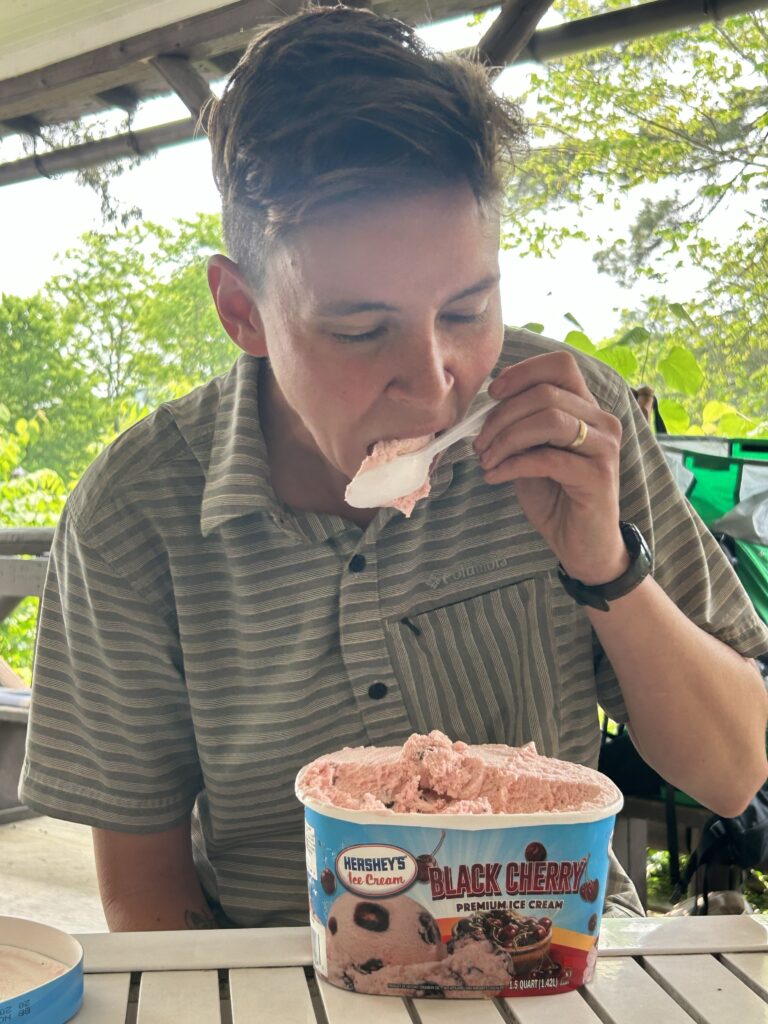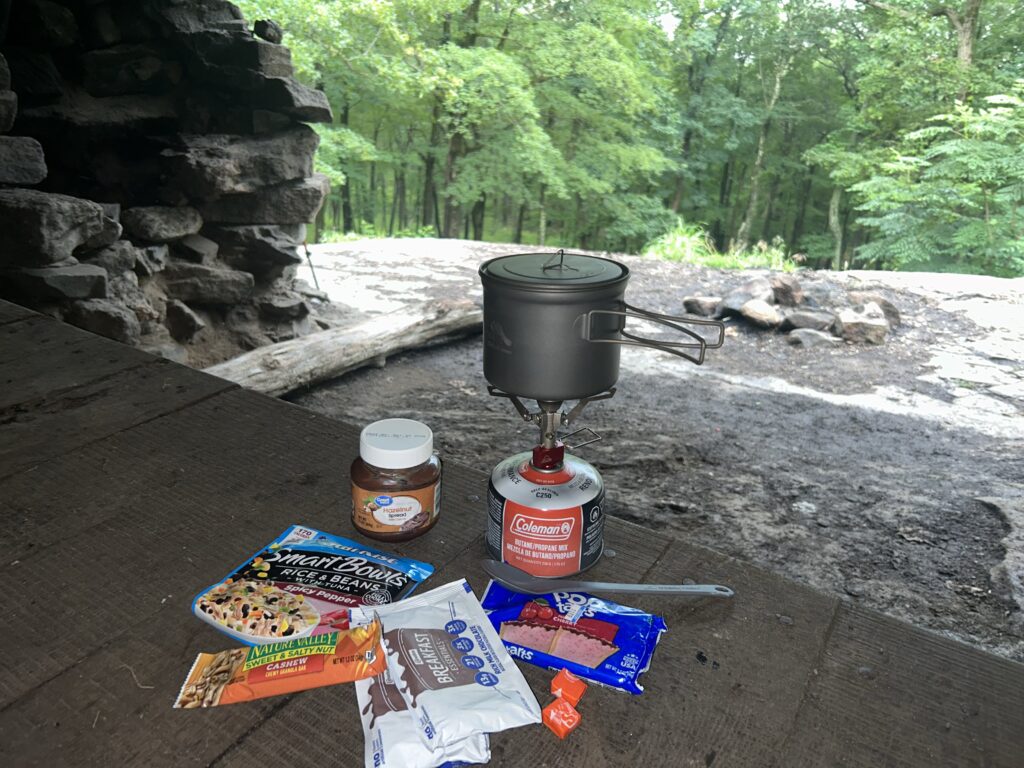After day after day of backpacking, many thru-hikers – myself included – feel like a bottomless pit. I feel like I could eat for days. This phenomenon is often referred to as “hiker hunger.”
Most thru-hikers end up losing a fair amount of weight on the trail. I am not trying to lose weight on the AT, but it’s inevitable. I’ve heard it said that the average long distance hiker burns through 5,000 to 6,000 calories each day. I estimate my expenditure is closer to 4,000, but still it’s pretty hard to eat enough to offset all those burned calories. It’s virtually impossible to NOT be in a calorie deficit.
I did intentionally gain some weight prior to starting the trail. Last fall and winter I put on 23 pounds to serve as a bit of a buffer so I don’t look like a complete skeleton in Maine. I don’t get to weigh myself often but last I checked I’ve lost around 20 pounds since starting the AT in March.
A Day in the Life of Trail Food
This is everything I ate yesterday, to give you an idea of an average day of food for me.
Breakfast
- 2 packages Carnation Breakfast Essentials
- Instant coffee
Morning Snacks
- 2 pop tarts
- Trail Magic!
- 1 Coke
- 1 Gatorade
- 1 Snickers Bar
Lunch
- 3 Tortilla wraps: tuna packet, Swiss cheese, handful of fresh spinach, taco sauce
- Spoonful of Nutella
Afternoon Snacks
- Snickers bar
- Protein bar
Dinner
- Instant Ramen
- Spam packet
- Slice of Swiss cheese
- Chicken of the woods mushrooms (foraged)
Dessert
- Tortilla and Nutella wrap
Isn’t that unhealthy?
If this sounds like a diet of junk food to you, well, you’re not wrong.
This is certainly not a doctor-approved recommended diet. But the food available to a thru-hiker is limited, and most will simply take the calories wherever they can get them.
Trips into town is when thru-hikers can really go to town, so to speak. It’s game-on for calorie consumption: burgers, fries, milkshakes, you name it. Oh and if you think of it, maybe a vegetable or two.

Many Factors to Balance
There is an irony to the fact that when you need your body at its best performance, you’re at your worst diet. I’m sure I’m missing micronutrients and that I’d feel even better with a higher quality diet, but this is what works with the constraints I have.
Obtaining food on a thru-hike requires is a balancing act of several factors:
- Shelf life – any food you buy needs to be able to last at least several days in your pack without spoiling. This is especially true in the summer when the hot weather will cause food to spoil quicker.
- Cost – You need to be able to feed yourself for 4-6 months. Fancy expensive food will add up quickly.
- Availability – Unless you’ve coordinated all your resupplies by mail, you are usually limited to what you can find in town. Sometimes you have access to grocery stores, other times it’s just a small general store, gas station, or Dollar General.
- Calories – You’re burning a lot and so you need to eat a lot.
- Nutritional value – To function at your best, you ideally would give your body the right balance of all your macro and micro nutrients.
- Packability – Everything has to fit in your pack. Delicate foods will get crushed.
- Weight – You have to carry your food on your back, so its weight matters. 500 calories of peanut butter weighs 3 ounces. 500 calories of celery weighs 8 pounds. Which would you carry?
In a perfect world, I could eat food that optimizes ALL of these factors. Unfortunately that’s just not feasible. I wish I could eat nutritionally perfect meals, but I have to compromise. My personal approach is to make getting lots of calories my number 1 priority, hence the high sugar and high fat foods seen in the sample day above. These high-calorie foods also happen to be cheap, accessible, and relatively low-weight. Oh, and they are yummy too.
It’s Not Forever
To be clear, this is NOT a sustainable way to eat. At home I normally enjoy eating a pretty clean diet. This is a temporary approach, reserved only for the special circumstances of thru-hiking.
I will say that long-distance hiking really makes you appreciate food. Everything tastes better on the trail. A hamburger is life-changing. Though I’ll leave the crappy diet behind, that type of appreciation – where food is never taken for granted – IS something I want to take with me back to real life.


While hiking in the Brooks Range I came across two young dudes (22, 23 years old) who were hiking for weeks on a daily diet of trail mix, JIF, and Nutella. THAT’S IT. Their “variety” was choosing which flavor of trail mix they were going to consume that day. To cut down on weight, they had one spoon between the two of them that they passed back and forth as they scooped “dinner” from their giant jars of nut and sugar goop. Oh yeah, and every other night they each got a packet of ramen. We offered them some of our food, even a tea bag or anything for an alternate flavor, and they politely refused, saying they thought it was best not to give themselves any variety that could make them less satisfied with their restricted diet for the weeks ahead.